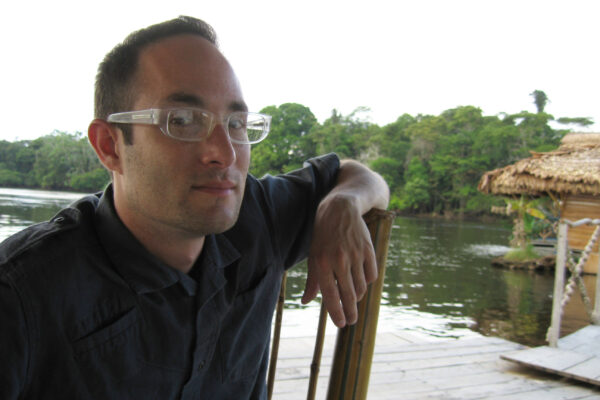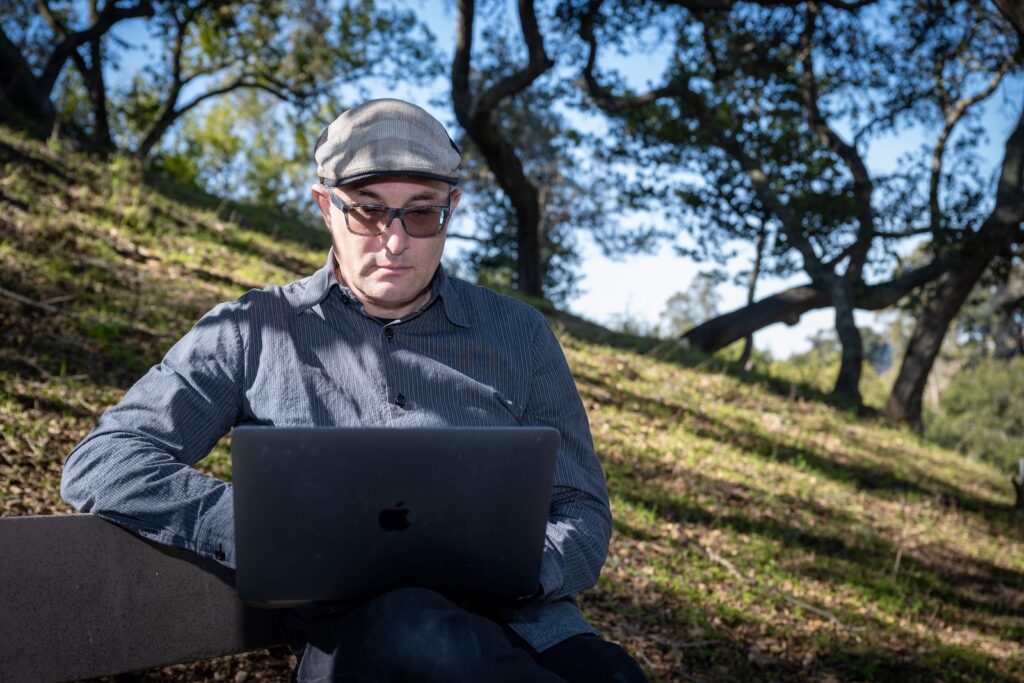Floating down the Amazon River, Dylan Chivian knew that he was in the midst of an adventure. This three-day journey downstream to Manaus, a heavily populated city in the State of Amazonas, was known to be a perilous one. But it was the locals’ way to go from point A to B in one of the wildest places on the planet. So Chivian, recently graduated from a doctoral program and confirmed to start a postdoctoral position at Berkeley Lab in the fall, purchased a hammock at the dock and boarded the river boat.
“I had always dreamed of seeing Brazil,” he said. As a biologist, the Amazon is a remarkable place. To a large extent, it’s the lungs of the planet.”

Chivian experienced enough wonder in the natural world to make this an unforgettable experience. Now a microbial scientist and coding engineer with the Department of Energy Systems Biology Knowledgebase (KBase), he’s building software tools that aim to share microbial genomic information and promote collaboration across the broader scientific community.
From producing biofuels to cleaning up pollutants, microbes present an array of solutions to our off-balanced biosphere—and may hold the key to stabilizing our environment. “We are still at the beginning of understanding the mechanisms of ecosystems and the toolkits that nature has evolved,” Chivian said.
From Dot-com to AI
Chivian’s upbringing instilled in him the idea that one’s job in life is to help humanity. When he was in his early teens, an organization that his father co-founded won the Nobel Peace Prize. Shortly thereafter, Chivian learned to code in the C programming language. These two important events led him to pursue bioengineering at the University of California, Berkeley.
In the early 1990s, the explosive growth of computers and the internet fascinated Chivian. Initially he explored a few of the dot-com–related job avenues, but the opportunities that existed between computing technology and science proved more appealing. “I got really into bioengineering—it felt like this field was at the beginning of a burst of discovery,” he said. Putting his programming skills to use, Chivian started to explore ways that physical and statistical modeling, as well as artificial intelligence (AI), could be used to study protein structure.
By better understanding the chemical makeup and atomic structure of a protein, it’s possible to infer a plethora of functional information. The potential for discovery seemed endless to Chivian and he followed this interest to a graduate program at the University of Washington. Working with David Baker, his research there culminated in the development of a protein structure prediction tool called Robetta. “This early advancement showed me how much I enjoy making tools that are simple to use by the greater community,” Chivian said. “I realized how much they can help advance science as a whole.”
Mining for Genomic Gold
Chivian began a postdoctoral position at Berkeley Lab in 2005. He joined the team of Adam Arkin, a senior faculty scientist in the Environmental Genomics and Systems Biology Division whose lab explores how to predict, control, and design biological function in complex webs of life.
Chivian focused his research on analyzing the genomic information of a water sample from a gold mine in Africa. When mining, the workers avoid water sources, but for Chivian and the team, these fluid-filled pockets hold valuable information about the type of microorganisms that can live in belowground conditions. After removing the cells from these samples and sequencing the DNA, Chivian analyzed the information and determined which species were present.
The results of this work surprised everyone on the team. Instead of multiple organisms collaboratively living in this contained, resource-barren environment, they discovered only one. After investigating the genetic potential of that genome, the team discovered that it was capable of carrying out every one of the necessary steps to maintain life. “It was literally a single-species ecosystem,” Chivian said.
This one organism, they soon learned, could fix its own nitrogen and carbon, and used sulfate reduction for energy. Chivian dubbed the species Desulforudis audaxviator, taking the name “audax viator” (bold traveler) from a passage in Jules Verne’s “Journey to the Center of the Earth.” It was a big discovery with implications for other fields like astrobiology and led to Chivian’s first publication in a major scientific journal. “It was one of those eureka moments that all scientists work toward,” he said. “It was amazing.”
Growing with Berkeley Lab
In 2008, Chivian converted to a research scientist position and began working at the Joint BioEnergy Institute (JBEI), which at that time was in its initial days. Chivian’s tasks centered on developing computational tools to model protein structures, perform metagenomic analysis, and map metabolic networks. The JBEI mission, to harness the energy in plants and develop advanced biofuels, closely aligned with Chivian’s interests. He continued developing tools to explore and analyze how microbes could be used to break down the tough, lignocellulose bonds of plants and unlock their full energy potential. “At that time, microbial genomics was arguably the most exciting place to be in science, the discoveries—such as CRISPR/Cas—were just falling out,” he said.

So many discoveries and new avenues to pursue kept arising that Chivian helped to build the Department of Energy Systems Biology Knowledgebase (KBase), a new user-focused tool in 2011. It’s a high-performance computing platform with an easy-to-use interface that helps scientists analyze massive amounts of information. Chivian focuses on building solutions that help scientists analyze metagenomic samples, which contain multiple genomes of many different types of cells.
Chivian uses computer coding and an operating system called Unix to build tools that integrate users’ genomic data into a larger database and knowledge-generating framework. Ultimately, he and his KBase colleagues are working toward modeling the biological and systems interpretation of genomic information. “The foundation of life on Earth is microbial and we’re just beginning to understand how that works,” Chivian said. “The opportunities from agricultural improvements to combating climate change feel endless.”
Reconnecting to Nature
Chivian’s enjoyment of the natural world and its wonders inspires his work, as well as many of his family activities. His wife and two sons get outside often and seek out opportunities to connect with nature. Prior to the COVID-19 pandemic, the Chivians spent their Thanksgiving holiday as a family at an elephant sanctuary in Thailand. “We got to feed and help bathe the elephants, it was really special,” he said. “We called it ‘Kap khun giving’,” a playful combination of the Thai translation for “thank you” and the American holiday.

For Chivian, staying connected to nature is relevant to his work with KBase and is fundamentally important. And helping his children explore and establish a relationship with the environment is an ongoing project. “We’ve lost our connection to how life works and how we fit into that balance,” Chivian said. “We have to change our perspective in order to last.” ⬢
Written by Ashleigh Papp, a communications specialist for Berkeley Lab’s Biosciences Area.
Read other profiles in the Behind the Breakthroughs series.




